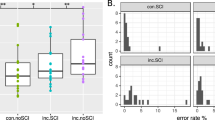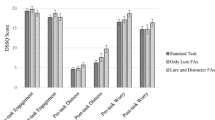Abstract
Sixty-one participants performed a sustained attention task in which they were required to respond to a critical signal requiring feature discrimination. Three separate groups performed the task with different global display configurations. The local feature elements (directional arrow shapes) were displayed on either a circle, a circle broken apart or a reconnected figure. For two of the groups, the entire display consisted of a clear global shape (circle and reconnected), and for one of the groups, the display had no discernible global element (broken circle) despite the critical signal being the same for all the groups. Analyses of hit rate and A′ scores indicated that the broken circle group had impaired performance compared to the global figure groups. A configural superiority effect was found in which performance was improved by having a global shape property to the entire display. These results provide a behavioural base for further research utilizing measures of cerebral activation, as cerebral activity during vigilance tasks may be dependent on both task difficulty and hierarchical aspects of the display. The configurable or hierarchical aspects of vigilance displays may be critical in understanding sustained attention performance and its hemispheric lateralization.




Similar content being viewed by others
References
Bennett KB, Flach JM (2011) Display and interface design: subtle science, exact art. CRC Press, Boca Raton
Berman KF, Weinberger DR (1990) Lateralisation of cortical function during cognitive tasks: regional cerebral blood flow studies of normal individuals and patients with schizophrenia. J Neurol Neurosurg Psychiatry 53(2):150–160
Buchsbaum MS, Nuechterlein KIH, Haier RJ, Wu J, Sicotte N, Hazlett E, Asarnow R, Potkin S, Guich S (1990) Glucose metabolic rate in normals and schizophrenics during the continuous performance test assessed by positron emission tomography. Br J Psychiatry 156:216–227
Cohen RM, Semple WE, Gross M, Holcomb HH, Dowling SM, Nordahl TE (1988) Functional localization of sustained attention: comparison to sensory stimulation in the absence of instruction. Neuropsychiatry Neuropsychol Behav Neurol 1:3–20
De Joux N, Russell PN, Helton WS (2013) A functional near-infrared spectroscopy study of sustained attention to local and global target features. Brain Cogn 81(3):370–375
Diamond SJ (1979a) Performance by split-brain humans on lateralized vigilance tasks. Cortex 15:43–50
Diamond SJ (1979b) Tactual and auditory vigilance in spilt-brain man. J Neurol Neurosurg Psychiatry 42:70–74
Ellenberg L, Sperry RW (1979) Capacity for holding sustained attention following commissurotomy. Cortex 15(3):421–438
Ferrari M, Bisconti S, Spezialetti M, Moro SB, Di Palo C, Placidi G, Quaresima V (2014) Prefrontal cortex activated bilaterally by a tilt board balance task: a functional near-infrared spectroscopy study in a semi-immersive virtual reality environment. Brain Topogr 27(3):353–365
Friedman A, Polson MC (1981) Hemispheres as independent resource systems: limited-capacity processing and cerebral specialization. J Exp Psychol Hum Percept Perform 5:1031–1058
Friedman A, Polson MC, Dafoe CG, Gaskill SJ (1982) Dividing attention within and between hemispheres: testing a multiple resources approach to limited-capacity information processing. J Exp Psychol Hum Percept Perform 8(5):625
Funke ME, Warm JS, Matthews G, Riley M, Finomore V, Funke GJ,… Vidulich MA (2010) A comparison of cerebral hemovelocity and blood oxygen saturation levels during vigilance performance. In: Proceedings of the human factors and ergonomics society annual meeting, vol 54, no 18, pp 1345–1349. SAGE Publications
Funke G, Funke M, Dillard M, Finomore V, Shaw T, Epling S,… Parasuraman R (2012) Cerebral hemovelocity and the sustained attention to response task (SART). In: Proceedings of the human factors and ergonomics society annual meeting, vol 56, no 1, pp 1436–1440. SAGE Publications
Gur RC, Alsop D, Glahn D, Petty R, Swanson CL, Maldjian JA, Turetsky BI, Detre JA, Gee J, Gur RE (2000) An fMRI study of sex differences in regional activation to a verbal and a spatial task. Brain Lang 74(2):157–170
Head J, Helton WS (2015) Passive perceptual learning versus active searching in a novel stimuli vigilance task. Exp Brain Res 233(5):1481–1489
Helton WS, Hollander TD, Tripp LD, Parsons K, Warm JS, Matthews G et al (2007) Cerebral hemodynamics and vigilance performance. J Clin Exp Neuropsychol 29:545–552
Helton WS, Hayrynen L, Schaeffer D (2009) Sustained attention to local and global target features is different: performance and tympanic membrane temperature. Brain Cogn 71(1):9–13
Helton WS, Warm JS, Tripp LD, Matthews G, Parasuraman R, Hancock PA (2010) Cerebral lateralization of vigilance. A function of task difficulty. Neuropsychologia 48:1683–1688
Herdman CM, Friedman A (1985) Multiple resources in divided attention: a cross-modal test of the independence of hemispheric resources. J Exp Psychol Hum Percept Perform 11(1):40
Hitchcock EM, Warm JS, Mathews G, Dember WN, Shear PK, Tripp LD, Mayleben DW, Parasuraman R (2003) Automation cueing modulates cerebral blood flow and vigilance in a simulated air traffic control task. Theor Issues Ergon Sci 4:89–112
Julesz B (1978) Perceptual limits of texture discrimination and their implications to figure-ground separation. In: Leeuwenberg E, Buffart H (eds) Formal theories of perception. Wiley, New York, pp 205–216
Keppel G, Zedeck S (2001) Data analysis for research designs. W.H. Freeman and Co, New York
Kimchi R (1988) Selective attention to global and local levels in the comparison of hierarchical patterns. Percept Psychophys 43(2):189–198
Kimchi R (1992) Primacy of holistic processing and global/local paradigm: a critical review. Psychol Bull 112:24–38
Kimchi R, Palmer SE (1982) Form and texture in hierarchically constructed patterns. J Exp Psychol Hum Percept Perform 8(4):521
Lamb MR, Robertson LC (1990) The effect of visual angle on global and local reaction times depends on the set of visual angles presented. Percept Psychophys 47:489–496
Lewin JS, Friedman L, Wu D, Miller DA, Thompson LA, Klein SK et al (1996) Cortical localization of human sustained attention: detection with functional MR using a vigilance paradigm. J Comput Assist Tomogr 20:695–701
Lux S, Marshall JC, Ritzl A, Weiss PH, Pietrzyk U, Shah NJ, Zilles K, Fink GR (2004) A functional magnetic resonance imaging study of local/global processing with stimulus presentation in the peripheral visual hemifields. Neuroscience 124:113–120
Martin M (1979) Local and global processing: the role of sparsity. Mem Cognition 7(6):476–484
Miller J (1981) Global precedence in attention and decision. J Exp Psychol Hum Percept Perform 7(6):1161
Navon D (1977) Forest before the trees: the precedence of global features in visual perception. Cogn Psychol 9:353–383
Nelson JT, McKinley RA, Golob EJ, Warm JS, Parasuraman R (2014) Enhancing vigilance in operators with prefrontal cortex transcranial direct current stimulation (tDCS). Neuroimage 85:909–917
Ong M, Russell PN, Helton WS (2013) Frontal cerebral oxygen response as an indicator of initial attention effort during perceptual learning. Exp Brain Res 229:517–578
Paquet L, Merikle PM (1984) Global precedence: the effect of exposure duration. Can J Psychol/Revue canadienne de psychologie 38(1):45
Parasuraman R, Warm JS, See JE (1998) Brain systems of vigilance. In: Parasuraman R (ed) The attentive brain. MIT Press, Cambridge, pp 221–256
Pomerantz JR (1983) Global and local precedence: selective attention in form and motion perception. J Exp Psychol Gen 112(4):516
Pomerantz JR, Kubovy M (1986) Theoretical approaches to perceptual organization: simplicity and likelihood principles. Organization 36:3
Pomerantz JR, Pristach EA (1989) Emergent features, attention, and perceptual glue in visual form perception. J Exp Psychol Hum Percept Perform 15(4):635
Pomerantz JR, Sager LC, Stoever RJ (1977) Perception of wholes and of their component parts: some configural superiority effects. J Exp Psychol Hum Percept Perform 3(3):422
Proctor CA, Ungar NR, Warm JS, Matthews G, Dember WN, Shaw T (2004) Investigation of the figure superiority effect in sustained attention. In: Proceedings of the human factors and ergonomics society annual meeting, vol 48, no 16, pp 1938–1942. SAGE Publications
Rosenthal R, Rosnow RL (1985) Contrast analysis: focused comparisons in the analysis of variance. CUP Archive, Cambridge
Rosenthal R, Rosnow RL, Rubin DB (2000) Contrasts and effect sizes in behavioral research: a correlational approach. Cambridge University Press, Cambridge
Rosnow RL, Rosenthal R (1996) Computing contrasts, effect sizes, and counternulls on other people’s published data: general procedures for research consumers. Psychol Methods 1(4):331
Ross HA, Russell PN, Helton WS (2014) Effects of breaks and goal switches on the vigilance decrement. Exp Brain Res 232(6):1729–1737
Ruxton GD, Beauchamp G (2008) The application of genetic algorithms in behavioural ecology, illustrated with a model of anti-predator vigilance. J Theor Biol 250(3):435–448
Shaw TH, Warm JS, Finomore V, Tripp L, Matthews G, Weiler E et al (2009) Effects of sensory modality on cerebral blood flow velocity during vigilance. Neurosci Lett 461:207–211
Shaw TH, Satterfield K, Rameriz R, Finomore V (2013) Using cerebral hemovelocity to measure workload during a specialized auditory vigilance task for novice and experienced observers. Ergonomics 8:1251–1263
Stanislaw H, Todorov N (1999) Calculation of signal detection theory measures. Behav Res Meth Ins C 31(1):137–149
Stroobant N, Vingerhoets G (2000) Transcranial Doppler ultrasonography monitoring of cerebral hemodynamics during performance of cognitive tasks: a review. Neuropsychol Rev 10(4):213–231
Szalma JL, Warm JS, Matthews G, Dember WN, Weiler EM, Meier A, Eggemeier FT (2004) Effects of sensory modality and task duration on performance, workload, and stress in sustained attention. Hum Factors 46:219–233
Van Kleeck MH (1989) Hemispheric differences in global versus local processing of hierarchical visual stimuli by normal subjects: new data and a meta-analysis of previous studies. Neuropsychologia 27(9):1165–1178
Warm JS, Matthews G, Parasuraman R (2009) Cerebral hemodynamics and vigilance performance. Mil Psychol 21(Supplement 1):S75–S100
Wickens CD (1980) The structure of attentional resources. In: Nickerson R (ed) Attention and performance VIII. Erlbaum, Hillsdale, pp 239–257
Wickens CD (1984) Processing resources in attention. In: Parasuraman R, Davies R (eds) Varieties of attention. Academic Press, New York, pp 63–101
Wickens CD (2008) Multiple resources and mental workload. Hum Factors 50(3):449–455
Wickens CD, Hollands JG (2000) Engineering psychology and human performance, 3rd edn. Prentice Hall, Upper Saddle River
Yamaguchi S, Yamagata S, Kobayashi S (2000) Cerebral asymmetry of the “top-down” allocation of attention to global and local features. J Neurosci 20:1–5
Author information
Authors and Affiliations
Corresponding author
Rights and permissions
About this article
Cite this article
de Joux, N.R., Wilson, K., Russell, P.N. et al. The configural properties of task stimuli do influence vigilance performance. Exp Brain Res 233, 2619–2626 (2015). https://doi.org/10.1007/s00221-015-4331-8
Received:
Accepted:
Published:
Issue Date:
DOI: https://doi.org/10.1007/s00221-015-4331-8




